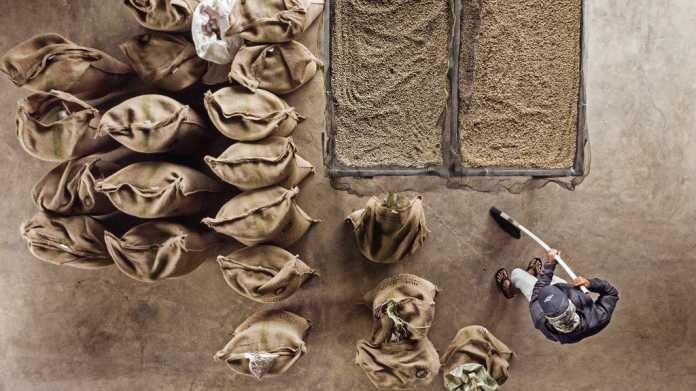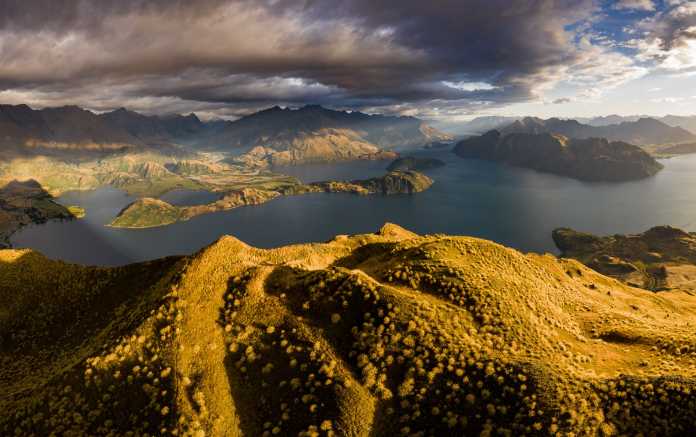The Swiss Stefan Forster has made a name for himself internationally as a landscape and drone photographer. Its extensive archive contains numerous drone recordings of places that are no longer so easily accessible for photographers and filmmakers today. The material is therefore in great demand with customers such as the BBC and Netflix. In an interview with c’t Photography he talks about why he traded his employee life for a life as a freelance photographer, how he keeps himself physically fit for his extreme tours and why he prefers to leave his drone in his backpack at the weekend.
How and when did you discover landscape photography for yourself?
I was a rather unusual child. Instead of playing with friends and going on vacation later, I was mostly alone in the forest and enjoyed the peace and solitude. Colors and shapes have always fascinated me. Likewise the power of nature. Thunderstorms, waves, storms – the more you felt nature, the better. Photography came in later. At first, photography was a kind of legitimation for me to be able to be outside. This legitimation later became an appointment. In the meantime, my camera always travels with me and my brain as a reminder. With almost 200 days a year traveling, you experience so much that you can no longer absorb everything.
How do you prepare your shoots, do you have a precise plan before you set off?
My pictures live from the weather and light moods. Of course, it is very important that I plan the picture in advance so that I know my way around the site and know exactly what focal length (lens) I have to stand at which location. For this I use software like The Photographer’s Ephemeris (TPE) and TPE 3D. In advance, I also go to a location a few times and mark the locations on my map. In order to be able to record special lighting moods, I then also wait for exciting light, which occurs frequently, especially when the weather changes. With stable high pressure phases there are usually no good lighting moods and blue sky is not my thing anyway.
Are your photo tours a physical challenge?
It is essential for a landscape photographer to stay physically fit. I train in the mountains every week. My favorite tour takes me from the Rhine Valley to the Hohe Kasten or the Stauberen Kanzel. 1240 meters in altitude, which I try to conquer several times a week when I’m at home. On the photo tours themselves, I differentiate between photo trips with customers and photo trips on which I’m traveling alone. On customer trips, the average is one to three hours of hiking a day. When traveling for my own purposes, I focus on finding new places and climbing hills and mountains. Sometimes it happens that I lose up to twelve kilograms in weight during a four-week trip, which I unfortunately only fed back all too quickly due to my second passion, food.
Do you work alone or is there a team?
I’m the “lone wolf” type, like all nature and landscape photographers are. I love the solitude and independence in my job. Being employed was never my thing and I was always a horror for every employer. The happiest day of my life was the one when I was able to start my own business. My team consists of some friends who offer courses for me and of course my wonderful wife Iris. She makes sure that everything runs smoothly and that the ship doesn’t sink. You only ever see my work and my stories, but it is she who keeps my back free and thanks to which I can practice my job with such concentration in the first place.

What are the challenges when shooting with drones?
My advantage with all of the drone photography and videography was that I was one of the first in the world to invest in the drone. I was still able to film and take photos with the drones in countries where drones are banned today and only possession of the drone is punishable by imprisonment. Initially, people took great pleasure in these flying giants with a single-lens reflex camera. It is now like it was when the cars piled up; Rules have to be found in order to be able to control the drones or their pilots, which have been bought millions of times. The difficulty now is to get a permit to fly. This is either priceless or you have to be able to show a private pilot’s license.
You write about “extreme logistical problems” on your website, could you please give an example.
The cameras are getting smaller and smaller, but you take more of them with you. Working with a drone also requires a lot of electricity. Unfortunately, electricity is not always available in the places where I travel, so I sometimes have to work with large solar systems or even portable electricity generators. If it is a multi-day tour, where you still have the packraft (backpack boat), tent, sleeping bag and provisions with you, you are faced with these logistical problems that every member of the expedition has to struggle with.
What kind of drone, camera, lens and filter are you using?
I’ve worked with Nikon for about ten years and am a fan of the Nikon Z system, especially the Z9. I would never trade my mirrorless cameras for an SLR again. The weight and pack size advantage is simply too great. And once you get used to the real-time histogram in the digital viewfinder, you don’t want anything else. For the lenses I use the Nikkor Z 14-30 mm, 24-120 mm and 100-400 mm. Animal shots are created with the 180-400 mm and the 500 mm. When it goes into the air, I currently use the DJI Mavic 3 Cine, DJI Mavic 2 Pro and, if necessary, the DJI Inspire 2.
What role does image processing play in your recordings?
Image processing is of course essential when recording RAW files. However, since I am constantly short of time and want to spend the little time I am at home with my family, I am extremely minimalist when it comes to developing the images. I often hear that I could have gotten more out of individual images. But that is not my strength and not my goal. If the sky wasn’t pink, it wasn’t. Then I come back to the place so often until the sky is pink. As a photographer tour guide, I have this opportunity again and again.
“Now I fl y where no one sees or hears me, without exception.” Is it still that easy to do?
Unfortunately, since there have been so many of them, drones no longer enjoy a good reputation. The media have done a brilliant job here again. Drone bashing is a popular headline. In order not to exacerbate this displeasure, I decided three years ago, whenever possible, to only fly when nobody is around and I definitely couldn’t bother anyone. Flying on the weekends is taboo, also on days when many people hike. Even if I am legally allowed to fly, I will do without. When it comes to animals, I also make sure that I don’t fly when there are escape animals around. Animals that are not aware of any danger from the air, however, react extremely relaxed to drones. Last spring I was able to film wild pumas from a few meters away with the drone for the BBC, the animals didn’t bother each other on the drone. Especially nature and documentary films would no longer be conceivable today without a drone.
How important has filming become for you as a photographer?
Even though I would never have thought it possible a few years ago, the income from license sales of my films (aerial photos) exceeds that of my photographs for books and calendars many times over. Due to the travel problems caused by the pandemic, many producers are dependent on buying existing footage. Since I often travel to remote areas on my photo trips and have been able to record rare film material, I now have an archive that is widely used by clients such as the BBC, Netflix, Google and LG. So for me, at least financially, photography is increasingly taking a back seat. With the Nikon Z9, with which I can now record 8K in RAW at 60 FPS, I plan to invest a lot more in my floor archive in the future.
You can find the fascinating pictures by Stefan Forster, for example, on his website or in the portfolio of c’t Photography. From January 2022 he will tour Switzerland with his new lecture “The World from Above”.

Stefan Forster took this aerial photo in New Zealand.
(Image: Stefan Forster Photography)

(sea)

